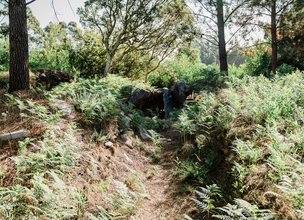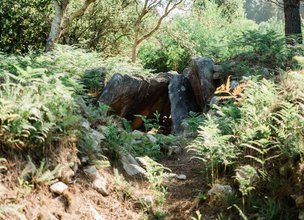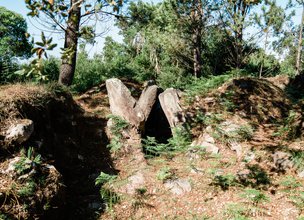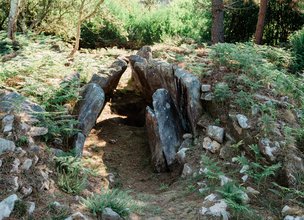Prehistoric tomb that is located at the north entrance of the parish, this being one of the megalithic monuments found closest to the coast, until today. The Mamoa of Eireira is a megalithic funerary monument that was discovered by the team of the archaeologist, Eduardo Jorge and with the collaboration of the N.A.I.A.A., being one of the best conserved and most important monuments in the Northwest Peninsular. Some paintings were found and a stone was removed, which is on display at the Museological Museum of Afife. Eireira's tumulus is undoubtedly the most significant manifestation of the Neolithic in Afife. It has a diameter of 28 m and what remains is made up of 16 pillars, which define an undifferentiated “V” shaped monument.
One of the most important characteristics, in terms of megalithic typology, is the fact that the pillars considered as “halls” are of the same height as those that constitute the chamber.
The monuments of this type, also known as "Dolmens" were tombs of collective burials, which developed from the Neolithic to the Early Bronze Age, that is to say from the fifth to the second millennium before Christ.
Prehistoric tomb that is located at the north entrance of the parish, this being one of the megalithic monuments found closest to the coast, until today. The Mamoa of Eireira is a megalithic funerary monument that was discovered by the team of the archaeologist, Eduardo Jorge and with the collaboration of the N.A.I.A.A., being one of the best conserved and most important monuments in the Northwest Peninsular. Some paintings were found and a stone was removed, which is on display at the Museological Museum of Afife. Eireira's tumulus is undoubtedly the most significant manifestation of the Neolithic in Afife. It has a diameter of 28 m and what remains is made up of 16 pillars, which define an undifferentiated “V” shaped monument.
One of the most important characteristics, in terms of megalithic typology, is the fact that the pillars considered as “halls” are of the same height as those that constitute the chamber.
The monuments of this type, also known as "Dolmens" were tombs of collective burials, which developed from the Neolithic to the Early Bronze Age, that is to say from the fifth to the second millennium before Christ.
Location
Afife
Coordinates
Lat: 41.7926688
Long: -8.8672504
Hello little one!
I'm Piquinhos and I can help you learn more about the Geopark!
Technical details
Child Mode
Discover the geopark in a simpler format, aimed at the little ones.
Clique ENTER para pesquisar ou ESC para sair






